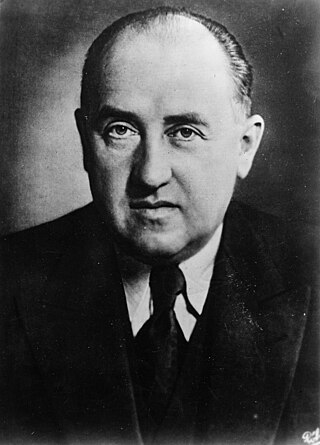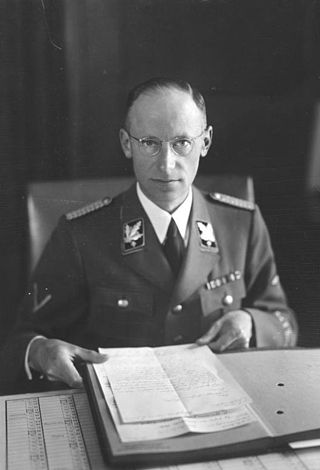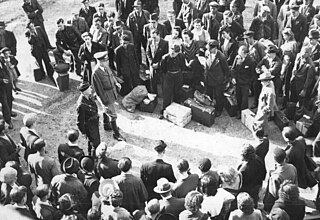Related Research Articles

Berthold Konrad Hermann Albert Speer was a German architect who served as the Minister of Armaments and War Production in Nazi Germany during most of World War II. A close ally of Adolf Hitler, he was convicted at the Nuremberg trial and sentenced to 20 years in prison.

Walther Funk was a German economist and Nazi official who served as Reich Minister for Economic Affairs (1938–1945) and president of Reichsbank (1939–1945). During his incumbency, he oversaw the mobilization of the German economy for rearmament and arrangement of forced labor in concentration camps. After the war he was tried and convicted as a major war criminal by the International Military Tribunal at Nuremberg. Sentenced to life in prison, he remained incarcerated until he was released on health grounds in 1957. He died three years later.

Fritz Todt was a German construction engineer and senior figure of the Nazi Party. He was the founder of Organisation Todt (OT), a military-engineering organisation that supplied German industry with forced labour, and served as Reich Minister for Armaments and Ammunition in Nazi Germany early in World War II, directing the entire German wartime military economy from that position.

Ernst Friedrich Christoph "Fritz" Sauckel was a German Nazi politician, Gauleiter of Gau Thuringia from 1927 and the General Plenipotentiary for Labour Deployment (Arbeitseinsatz) from March 1942 until the end of the Second World War. Sauckel was among the 24 persons accused in the Nuremberg Trial of the Major War Criminals before the International Military Tribunal. He was found guilty of war crimes and crimes against humanity, sentenced to death, and executed by hanging.

Erhard Milch was a German Generalfeldmarschall who oversaw the development of the German air force (Luftwaffe) as part of the re-armament of Nazi Germany (1933-1945) following World War I (1914-1918). He served as State Secretary in the Reich Ministry of Aviation from May 1933 until June 1944 and as Inspector General of the air force from February 1939 to January 1945. During most of World War II he was in charge of German aircraft production and supply. In the Milch Trial of 1947, a U.S. military court convicted Milch of war crimes and of crimes against humanity, sentencing him to life imprisonment. However, in 1951 John J. McCloy, the U. S. High Commissioner for Germany, commuted Milch's sentence to 15 years. Paroled in 1954, Milch died in 1972.

Oswald Ludwig Pohl was a German SS functionary during the Nazi era. As the head of the SS Main Economic and Administrative Office and the head administrator of the Nazi concentration camps, he was a key figure in the Final Solution, the genocide of the European Jews. After the war, Pohl went into hiding; he was apprehended in 1946. Pohl stood trial in 1947, was convicted of crimes against humanity, and sentenced to death. After repeatedly appealing his case, he was executed by hanging in 1951.
Friedrich Flick was a German industrialist and convicted Nazi war criminal. After the Second World War, he reconstituted his businesses, becoming the richest person in West Germany, and one of the richest people in the world, at the time of his death in 1972.

The Hitler cabinet was the government of Nazi Germany between 30 January 1933 and 30 April 1945 upon the appointment of Adolf Hitler as Chancellor of the German Reich by President Paul von Hindenburg. It was contrived by the national conservative politician Franz von Papen, who reserved the office of the Vice-Chancellor for himself. Originally, Hitler's first cabinet was called the Reich Cabinet of National Salvation, which was a coalition of the Nazi Party (NSDAP) and the national conservative German National People's Party (DNVP). The Hitler cabinet lasted until his suicide during the defeat of Nazi Germany. Hitler's cabinet was succeeded by the short-lived Goebbels cabinet, with Karl Dönitz appointed by Hitler as the new Reichspräsident.

Hans Heinrich Lammers was a German jurist and prominent Nazi Party politician. From 1933 until 1945 he served as Chief of the Reich Chancellery under Adolf Hitler. In 1937, he additionally was given the post of Reichsminister in the cabinet. During the 1948–1949 Ministries Trial, Lammers was found guilty of crimes against peace, war crimes, crimes against humanity, and membership in a criminal organization. He was sentenced to 20 years in prison in April 1949 but this was later reduced to 10 years and he was released early.

Herbert Friedrich Wilhelm Backe was a German politician and SS Senior group leader (SS-Obergruppenführer) in Nazi Germany who served as State Secretary and Minister in the Reich Ministry of Food and Agriculture. He was a doctrinaire racial ideologue, a long-time associate of Richard Walther Darré and a personal friend of Reinhard Heydrich. He developed and implemented the Operation Hunger that envisioned death by starvation of millions of Slavic and Jewish "useless eaters" following Operation Barbarossa, the 1941 invasion of the Soviet Union.

Paul Pleiger was a German entrepreneur and corporate executive who was involved in managing the war economy of Nazi Germany. He was the managing director of the Reichswerke Hermann Göring from 1937 and became chairman of its supervisory board in 1942. From 1941, he served as the Reich Delegate for Coal Supply and the chairman of the Reich Coal Association. He was convicted of war crimes and crimes against humanity by the Nuremberg Military Tribunal and sentenced to fifteen years imprisonment.

The SS Main Economic and Administrative Office was a Nazi organization responsible for managing the finances, supply systems and business projects of the Allgemeine-SS. It also ran the concentration camps and was instrumental in the implementation of the Final Solution through such subsidiary offices as the Concentration Camps Inspectorate and SS camp guards.

The Ministry of Aviation was a government department during the period of Nazi Germany (1933–45). It is also the original name of the Detlev-Rohwedder-Haus building on the Wilhelmstrasse in central Berlin, Germany, which today houses the German Finance Ministry.

The following is a bibliography of works devoted to the Nuremberg Trials.

The Service du travail obligatoire was the forced enlistment and deportation of hundreds of thousands of French workers to Nazi Germany to work as forced labour for the German war effort during World War II.

Central Continental Prisoner of War Enclosure No. 32, code-named Ashcan, was an Allied prisoner-of-war camp in the Palace Hotel of Mondorf-les-Bains, Luxembourg during World War II. Operating from May to August 1945, it served as a processing station and interrogation center for the 86 most prominent surviving Nazi leaders prior to their trial in Nuremberg, including Hermann Göring and Karl Dönitz.

Paul Körner was a German Nazi functionary who served as State Secretary of both the Prussian State Ministry and the Four Year Plan. A close associate of Hermann Göring, he was also an SS-Obergruppenführer and was convicted as a war criminal by the Nuremberg Military Tribunal.
Walter Schuhmann was a Nazi Party official who became head of the National Socialist Factory Cell Organization (NSBO). He also was a member of the SA and the SS.
References
- ↑ "Trials of the War Criminals Before the Nuernberg Military Tribunals, Volume II: The Milch Case, p. 374" (PDF). United States Printing Office. 1950. Retrieved 21 June 2021.
- ↑ Speer, Albert (1970). Inside the Third Reich. New York: Avon Books. p. 296. ISBN 978-0380000715.
- ↑ "Trials of the War Criminals Before the Nuernberg Military Tribunals, Volume II: The Milch Case, p. 374" (PDF). United States Printing Office. 1950. Retrieved 21 June 2021.
- ↑ Zentner, Christian; Bedürftig, Friedemann, eds. (1997) [1991]. The Encyclopedia of the Third Reich . New York: Da Capo Press. p. 19. ISBN 978-0-306-80793-0.
- ↑ "Trials of the War Criminals Before the Nuernberg Military Tribunals, Volume II: The Milch Case, p. 444" (PDF). United States Printing Office. 1950. Retrieved 21 June 2021.
- ↑ Fest, Joachim (1999). Speer: The Final Verdict. New York: Harcourt. pp. 169–170. ISBN 978-0-15-100556-7.
- ↑ Zentner & Bedürftig 1997, pp. 310, 897.
- ↑ Zentner & Bedürftig 1997, p. 591.
- ↑ Zentner & Bedürftig 1997, p. 511.